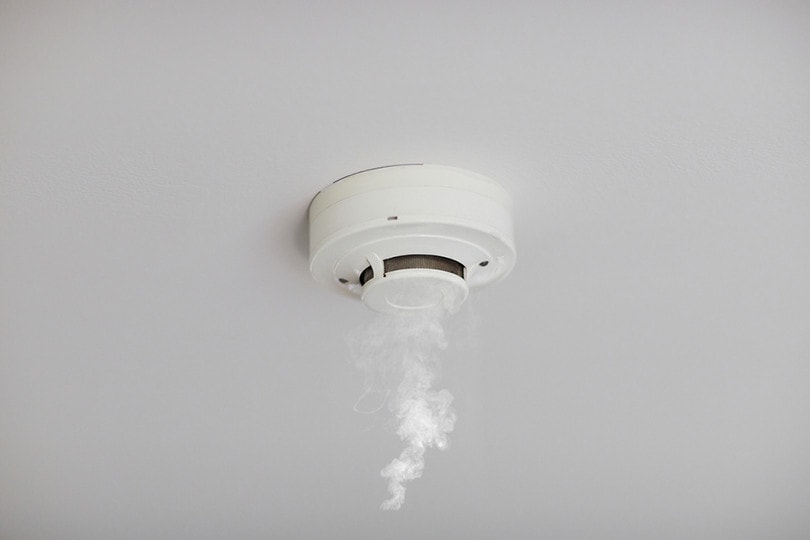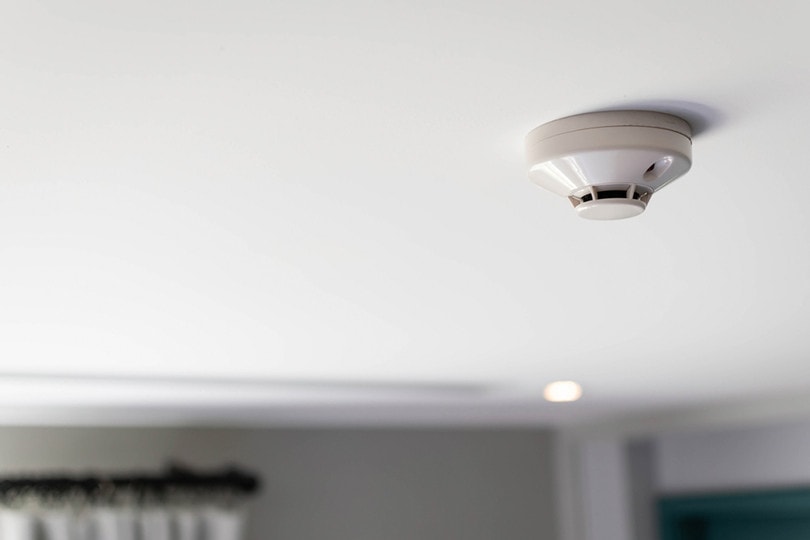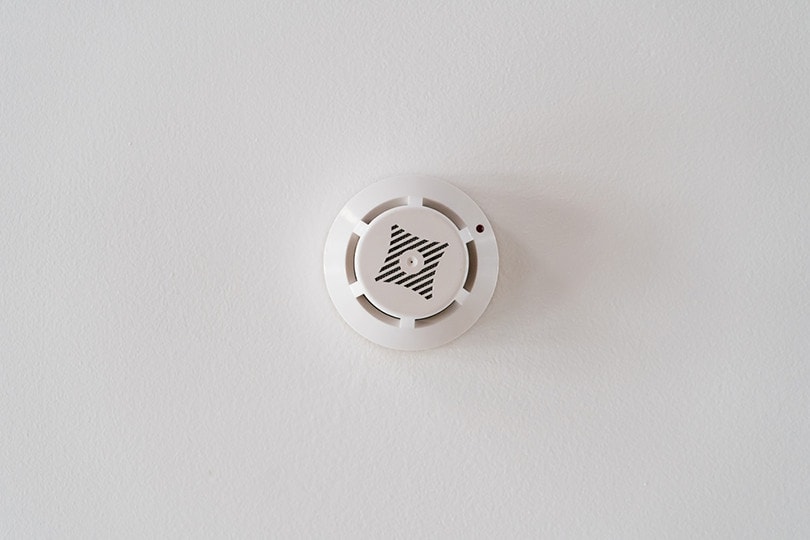What Is a Photoelectric Smoke Detector? Pros, Cons, Types, & FAQ
-
Codee Chessher
- Last updated:

Photoelectric smoke detectors, also called smoke alarms, are a popular form of smoke detector, but not the only one. Photoelectric smoke detectors are recommended throughout the home as well as other public and private buildings to help prevent deaths in fires. Since their invention, smoke detectors have saved countless lives by providing early warning of otherwise fatal fires. Let’s check out how these miracle devices work, other variants, and some other interesting info about them.

How Do Photoelectric Smoke Detectors Work?
Photoelectric smoke alarms have chambers that contain a light-sensitive sensor and an LED light. Normally, the LED light constantly beams across a stream of light to the sensor. When smoke drifts into the chamber, it interrupts this beam. When the alarm detects this, it triggers the alarm.
Photoelectric smoke detectors are best at detecting smoldering fires, which emit larger and more reflective smoke particles. Smoldering fires tend to smoke a lot more than flaming fires, but other smoke alarms are slower to detect this type of smoke. Some examples of smoldering fires are cigarettes and charcoal embers, which can smolder on their own or ignite other items to spread a smoldering or flaming fire.
Photoelectric smoke detectors have a lower rate of false alarms than ionization smoke alarms, meaning they’re at less risk of becoming nuisance alarms. A lower rate of malfunction means that photoelectric alarms are ostensibly safer, but research on the subject is slim. We do know, however, that hardwired smoke alarms are more likely to trigger in the event of a home fire. This might be worth looking into for your alarms at home.
As with all smoke alarms, photoelectric detectors aren’t perfect. In some cases, the smoke from a cooktop can trigger a false alarm, or smoking indoors can also trigger it. In some cases, alarms near bathrooms can get triggered by steam. False alarms are actually a testament to how sensitive smoke alarms are, but it’s extremely difficult to make a smoke alarm that doesn’t have false alarms.

Are There Different Types of Smoke Detectors?
Yes. There are two main types of smoke detectors: ionization and photoelectric. Over 90% of home smoke alarms are classified as ionization smoke detectors. We already know how the latter works, so let’s focus on ionization smoke detectors for a bit.
Ionization smoke detectors have a chamber where a tiny bit of radioactive material is suspended between electrically charged plates. The material creates an ionized area between the plates, and the detector constantly monitors the current level. When smoke wafts into the chamber, it lowers the current level, which triggers the alarm.
Ionization smoke alarms are more effective at detecting flaming fires, which means fires from flammable liquids, paper, wood, or other flammable substances. This is the most common type of house fire, which is why ionization smoke alarms are more popular in homes. However, recent recommendations from fire authorities recommend households invest in both ionization and photoelectric smoke detectors. Having both will protect you against all types of fires more effectively than just one type of detector.
Ionization smoke detectors are notably banned in some US states and communities because of the radioactive material used. The material isn’t dangerous to humans because it’s present in such small amounts, but mass storage and improper disposal may present some dangerous risks to the environment.
Finally, it’s important to mention that ionization smoke detectors have a higher rate of false alarms than photoelectric smoke detectors. This can cause nuisance alarms that go off when there’s no fire in the home, and people frequently remove the batteries of these alarms to get them to be quiet. Unfortunately, doing so can skyrocket your risk of dying in a home fire.

Where Are Photoelectric Smoke Detectors Used?
Smoke alarm location is the most critical factor in determining if the alarm will be useful in the event of a fire—even more useful than the type of smoke detector! Smoke alarms should be placed inside and outside of every sleeping area, plus every level of the home. For best results, alarms should be placed in the center of the ceiling in a space. The only spaces you should keep smoke alarms away from are cooking areas and showers, which can trigger false alarms.
While ionization smoke detectors are more common in homes, photoelectric smoke alarms are becoming commonplace as fire awareness spreads. Dual alarms with both types of sensors are also rising in popularity as homeowners seek to protect themselves most effectively. Other common locations for photoelectric smoke detectors are offices, which are also doubling down on fire safety.
Advantages of Photoelectric Smoke Detectors
Photoelectric smoke detectors have their fair share of pros, both versus ionization detectors and in general. Let’s check some out so you can stay informed on how they can improve your home’s safety.
- Great at detecting smoldering fires
- Helps slash the risk of dying in a home fire
- Less likely to cause false alarms than ionization smoke detectors
- More effective at reducing smoke inhalation

Disadvantages of Photoelectric Smoke Detectors
Unfortunately, photoelectric smoke detectors aren’t perfect and have their share of downsides. However, they’re so useful at reducing fire deaths that we typically overlook these flaws. Let’s check them out anyway, just so you can be aware of these issues.
- Less effective at detecting flaming fires than ionization smoke alarms
- Less widely available than ionization smoke alarms
- Awareness about these smoke alarms is relatively low
- Still suffers from false alarms, albeit at a lower rate

Frequently Asked Questions (FAQ)
Are photoelectric or ionization smoke detectors better?
Unfortunately, there’s no clear-cut winner between the two smoke detectors. Both photoelectric and ionization smoke detectors are great at preventing fire deaths, with slightly varying effectiveness rates. In some studies, they were equally effective at triggering in the event of a fire, while other studies were inconclusive.
Recently, it’s becoming popular to have a dual smoke detector that contains both photoelectric and ionization sensors. These alarms are effective at detecting both smoldering and flaming fires, and sometimes they come with carbon monoxide alarms too. Dual alarms are more expensive and harder to find, but they’re the best of both worlds for people focused on home safety.

What’s the difference between a battery and a hardwired smoke detector?
Hardwired smoke alarms are 14% more likely to trigger in the event of a fire versus battery-powered smoke alarms, which is a significant difference. Hardwired smoke alarms have battery backups in case the main power source gets disconnected, meaning they rarely malfunction. You also can’t just remove the batteries from a hardwired smoke alarm because the alarm will sound until the issue is fixed.
Hardwired smoke detectors are also more expensive to have installed and maintained because professionals are required. Most people simply use battery-powered smoke alarms because it’s easier to replace batteries than call a professional when you have issues.

Conclusion
Smoke alarms are an essential part of everyday life, protecting us from fires when we sleep. While most alarms are ionization detectors, photoelectric smoke alarms are very effective at sniffing out insidious smoldering fires. Consider combining both types with a dual smoke detector.
Featured Image Credit: Andrey_Popov, Shutterstock
Contents